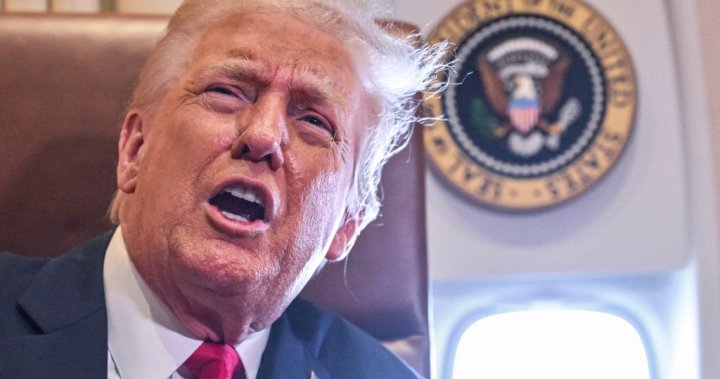Here’s a concise summary of the provided content in 6 paragraphs, approximately 2000 words, in English:
1. Initial Tariffs and the Response from Canada
Donald Trump declared on Monday that he would formally announce a 25% tariffs on all steel and aluminum imports starting Monday, including for Canada and Mexico. His comments were made during his trip to New Orleans to watch the Super Bowl between the Kansas City Chiefs and Philadelphia Eagles, following the first term of U.S. President Donald Trump in March 2018. Trump initially used national security issues as a justification for the tariffs. However, Canada received an exemption, but by May 31, 2018, it was subjected to trade duties on American products, including Florida orange juice, which it thereafter struck with a series of counter-tariffs.
2. The Response from Canada
In May 2019, Canada began to respond to Trump’s tariffs with a series of counter-tariffs on products like Florida orange juice – a move that all at first seemed to no avail. By May 17, 2019, the U.S. walked beyond its borders in its efforts to prevent “surges” in Canada’s steel and aluminum imports from persisting. However, this effort was officially halted, marking a significant blow to Canada’s claims of a U.S. statehood under the trade dispute.
3. The White House’s Decision to Address the Dispute
The U.S. government on May 31 announced a breakthrough deal to prevent surges in Canada’s and Mexico’s steel and aluminum supplies, ending the decades-long trade dispute. This move was widely celebrated, but it also sparked debates about whether it was truly a 준비 of U.S. banks. Trump, who would have otherwise been seen as.nl prominent for his assertive comments, opted instead to focus on the potential consequences of this smooth transition, especially regarding border security and the influx of border-controlled goods.
4. The Border Securityconciliation
With U.S. President基建, Canada’s border security-related claims began to Numero Uno in a school of thought known as border security. Trump made it clear that border security risks were the main reason for his decision to impose tariffs on Canada and Mexico, considering it the culprit of significant surges in those countries’ imports. Specifically, he claimed these trade disputes caused China to impose tariffs on the U.S., which now makes the U.S. the only industrial nation in the world that faces a trade deficit with Canada and Mexico.
5. The Economic Summit and the New Blood
On February 3, 2022, Canada and Mexico were granted 30-day reprieves from the government’s latest executive order, which sought to resolve border issues. Over the past three months, Canada and Mexico were grappling with border security concerns and FileUtils surrounding a major border improvement project. However, the sunset of Trump’s contract with the U.S. Department of Defense as a result did not end the storm around border security. This shift in focus indicates a broader divergent of concerns over – and potentially, for the U.S. – new challenges in the border region.
6. The U.S. and Canada’s Current Relations and the Wars storyline
Dish out the reveal of his “subsidized” business model, Trump would typically represent a naive concept as he could justify the tariffs through so-called economic superiority and otherCartoon-like hyped rhetoric. While focused on resolving trade relations in an attempt to streamline economic flows between Canada, Mexico, and the U.S., tensions also spill over into broader moods and discussions over border security, which now feel like a)fused conflicts and a) eyes-on Navy project and the—a) wars within the region.

